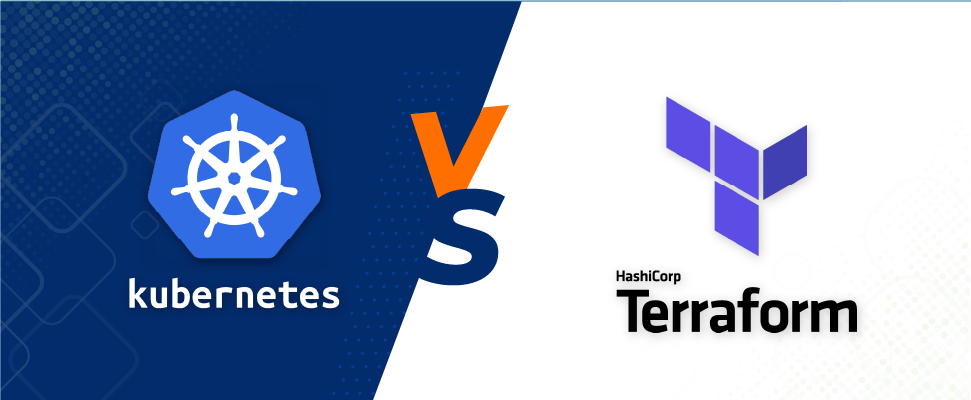Table of Contents
ToggleIntroduction
Kubernetes and Terraform are the leading tools in today’s cloud infrastructure. Both these languages exhibit similar characteristics, but their main purpose is different. Terraform is primarily used for infrastructure tools . On the other hand, Kubernetes is used for container orchestration.
What is Terraform?

Terraform is an open-source tool used for building and modifying the version control infrastructure. A simple way to define Terraform is that it is an IAC tool used by DevOps teams to automate infrastructure tasks. It is written in HashiCorp Configuration Language (HCL) which supports various service providers.
Key features of Terraform

- Multiple Cloud Provider: It allows easy switching between cloud provider AWS to GCP without vendor lock-in.
- Infrastructure Code: It uses HCL to turn HCL infrastructure code into readable files and then reuse the template for infrastructure.
- Execute: Once described, it creates a plan and waits for approval before making any changes.
- Resource Graph: It generates a resource map and updates non-dependent resources simultaneously to ensure deep insight into your infrastructure.
- Complex Change Automation: Terraform applies these changes into infrastructure with minimal manual intervention. This feature is beneficial in analyzing configuration, determining changes, and incremental plans.
Use cases of Terraform
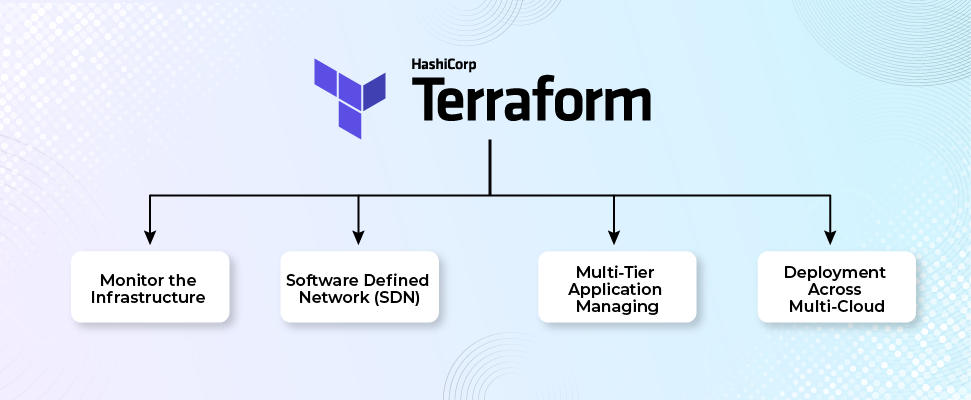
- Monitor the Infrastructure: Terraform uses a state file to keep track of resources whenever the resources are changed state file helps to determine changes required in the infrastructure to meet the final goal.
- Software Defined Network (SDN): Terraform’s ability to communicate with the SDN allows it to move ticket-based workflow and automate the deployment process, which significantly reduces the deployment time.
- Multi-Tier Application Managing: Terraform handles interdependencies of each tier by grouping them. Plugins and dependencies play a crucial role in maintaining the uniformity across the tiers. Though the manual installation can be challenging Terraform guarantees accurate installation and implementation every time.
- Deployment Across Multi-Cloud: Terraform is popular for its usage in any cloud. The HCL configuration file assists in managing cross-cloud dependencies and multi-cloud deployments. This, in return, improves robustness as well as the fault tolerance.
Pros and Cons of Terraform
| Pros | Cons |
|---|---|
| Multi-cloud deployments | Doesn’t support GKE |
| Versatile choice (Infrastructure as code) IaC | Bugs are common in new releases |
| Version control capabilities | Doesn’t support error handling |
| Easy to record, manage, and report change | Managing state files separately can be challenging |
| Modularity | Not beginner-friendly |
| Declarative syntax | Should be well-versed in HCL |
| Avoids downtime | Need to destroy the object and reapply |
| Readable documentation | Time-consuming and error-prone |

Don't miss out on your chance to work with the best!
Apply for top job opportunities today!
What is Kubernetes?
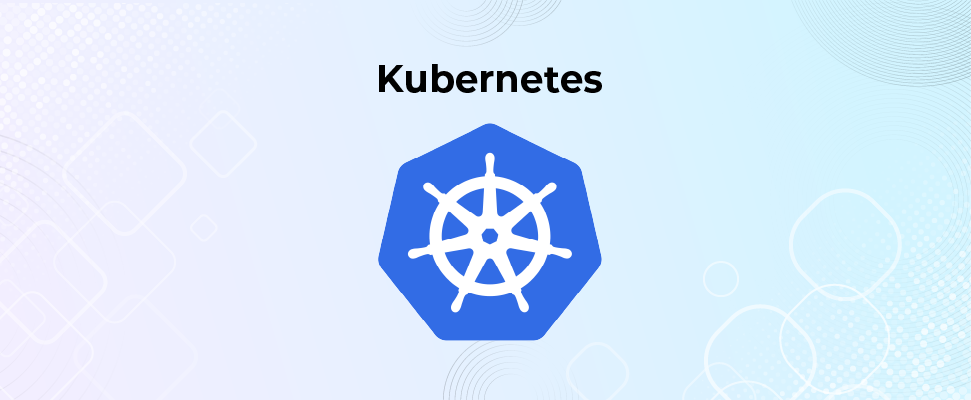
Kubernetes is a tool to manage container applications also known as the K8 system. This automates the deployment and management of the cloud on your own servers or in the public cloud. Kubernetes components consist of API server, scheduler, controller manager, and etcd. These work together to maintain the integrity of the cluster and facilitate node communication.
Key features of Kubernetes

- Automatic Scaling: It scales the container application and adjusts the size of the resources based on how they are being used.
- Lifecycle Management: Easy to automate deployment and updates with a roll-back and pause feature.
- Resilience: With features like auto-placement, auto-restart, auto-replication, and auto-scaling Kubernetes can easily recover from any issue.
- Advance DevOps Security: This feature creates safer automation in every step that allows developers to work efficiently.
Use cases of Kubernetes
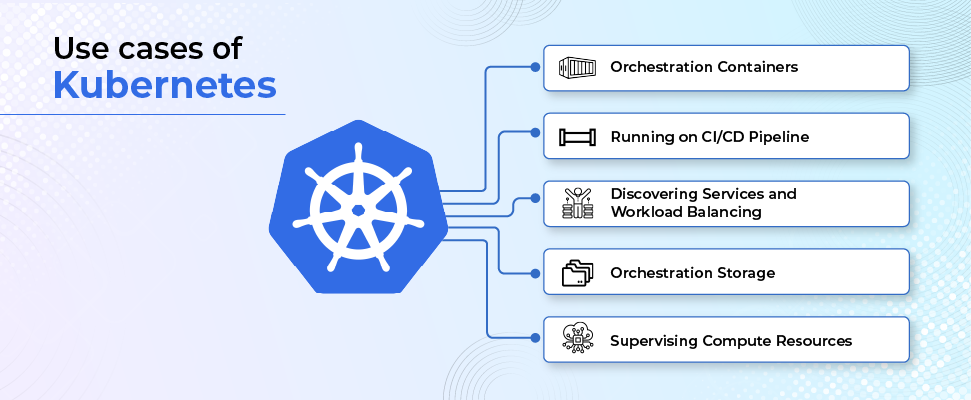
- Orchestration Containers on Multiple Hosts: Kubernetes being platform-independent lets hosting containers on various machines or the cloud. Its failover layers help to maintain high availability.
- Running on CI/CD Pipeline: Kubernetes is sought after for its CI/CD methodologies that as long as they are packed in a container, they will keep running in the CI/CD platform.
- Discovering Services and Workload Balancing: Kubernetes makes the container cluster service accessible to other platforms through the cluster’s DNS point. Load balance traffic is distributed to ensure the availability and stability of deployed instances when huge network traffic is encountered.
- Orchestration Storage: Kubernetes enables easy creation of storage of large volume data. You can also store it on any platform from network to cloud storage.
- Supervising Compute Resources: It is considerably budget-friendly and easier to host on the Kubernetes cluster rather than hosting on various servers.
Pros & Cons of Kubernetes
| Pros | Cons |
|---|---|
| Resource-friendly | Takes time to learn |
| Horizontal scaling | Some K8s is new so might not be stable |
| GitOps workflow | Needs necessary adjustments for workflow |
| Prevents infrastructure lock-ins | Limited services coverage |
| Secrets provide seamless integrations | Infrastructure orchestration is only possible |
| Container management tool | Complex troubleshooting |
| Extensive documentation | Vendor lock-in makes migrating harder |

Similarities between Terraform and Kubernetes
| How are Terraform and Kubernetes similar? | |
|---|---|
| DevOps Tools | Both are used by DevOps engineers and cloud engineers to automate and streamline software development and deployment processes. |
| Declarative Configuration | Share a common conceptual method to define configuration |
| Cloud Agnostic and Open Source | Similar approach to work smoothly across different clouds, platforms, and APIs |
| State Management | Both use logic to ensure the configuration files defined in the state matches with the actual files |
| CI/CD Compatibility | Offers advanced and automated workflow that can integrate well with the CI/CD pipeline |
| Extensibility | Provides extensive external plugins and integration to external plugins |
| Scalability | Supports a range of scale to accommodate scaling requirements of modern cloud-native environments |
Key differences: Kubernetes vs. Terraform
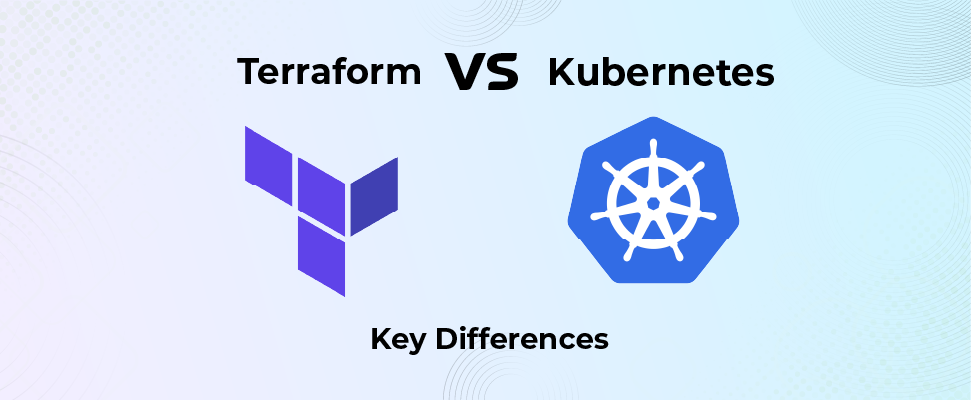
| Terraform | Kubernetes | |
|---|---|---|
| Focus Area | Provides infrastructure components | Container orchestration area |
| Configuration Language | Use Hashicrop Configuration Language (HCL) | Uses YAML and JSON files |
| Targets | Infrastructure as code | Container workload |
| Runs on/Usage | Runs on multiple cloud platforms | Interchangeable usage of YAML and JSON |
| Easy to Use | Welcoming experience to newbies | Familiarity with the cluster’s internal components and mechanics is a must |
| Configuration Drift | Notifies using the planning phase | Doesn’t provide functionality |
| Tools | Command-line interface to execute and manage | Kubectl allocates memory |
Concluding Thoughts
Terraform and Kubernetes are the two leading DevOps tools. Terraform is a single framework that enables automated declarative resources across various cloud platforms. Whereas Kubernetes excels in managing resource management, deployments, and load balancing in the container environments. So, which platform would you consider for your next project? Not sure? Then you can hire top Kubernetes and Terraform professionals from Olibr who can help you with your project! Sign up now!
Take control of your career and land your dream job!
Sign up and start applying to the best opportunities!

FAQs
A Kubernetes deployment is a resource object in Kubernetes that provides declarative updates to applications. it tells Kubernetes how to create or modify instances of the pods with a containerized application.
The HashiCorp Infrastructure Automation Certification can be obtained on the HashiCorp Developer website. The Terraform certification is aimed at Cloud Engineers who specialize in operations, IT, or development and have a basic understanding of HashiCorp Terraform.
Terraform can be used to provision and manage the underlying infrastructure (such as VMs, networks, and storage) for a Kubernetes cluster, but deploying and managing the Kubernetes components themselves (like pods, services, and deployments) typically requires additional tools or manifests.
Kubernetes is a powerful orchestration tool for managing containerized applications, but DevOps encompasses a broader set of practices and tools beyond just orchestration. While Kubernetes plays a crucial role in DevOps, other tools are needed for CI/CD, monitoring, and infrastructure as code.

